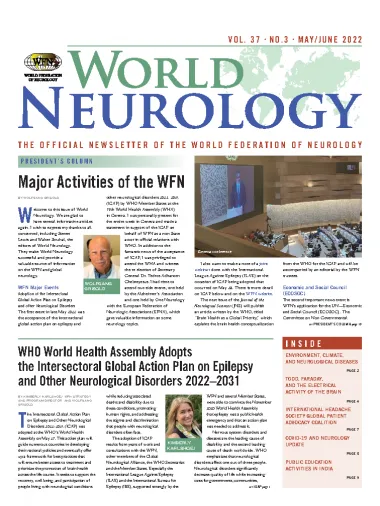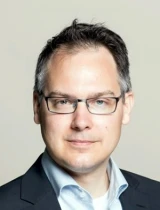 We'd like to welcome all readers to the May/June 2022 issue of World Neurology. The issue begins with the President's Column, where WFN President Dr. Wolfgang Grisold updates on many of the current and evolving global activities, major events, and projects that the WFN is involved in. Kimberly Karlshoej, WFN strategy and program director, updates us on the Intersectorial Global Action Plan on Epilepsy and Other Neurologic Disorders (IGAP) 2022-2031 and its recent adoption by the World Health Assembly.
We'd like to welcome all readers to the May/June 2022 issue of World Neurology. The issue begins with the President's Column, where WFN President Dr. Wolfgang Grisold updates on many of the current and evolving global activities, major events, and projects that the WFN is involved in. Kimberly Karlshoej, WFN strategy and program director, updates us on the Intersectorial Global Action Plan on Epilepsy and Other Neurologic Disorders (IGAP) 2022-2031 and its recent adoption by the World Health Assembly.
Dr. Mohammad Wasay and Dr. Safa Younis report on the recent webinar by the Environmental Neurology Specialty Group of the WFN on Environment, Climate, and Neurological Diseases. In this issue's History Column, Dr. Edward Reynolds discusses the early and pioneering concepts of the electrical activity of the brain and the roles of Robert Todd and Michael Faraday. This issue also features a COVID-19 and neurology update, edited by Dr. Chandrashekhar Meshram, and written by experts from the U.S. National Institutes of Health, Dr. B. Jeanne Billioux and Dr. Avindra Nath. Dr. Chandrashekhar Meshram, U Meenakshisundaram, Gagandeep Singh, and Nirmal Surya also report on the many recent public awareness activities of the Indian Academy of Neurology.
Also in this issue is an article about the International Headache Society recognizing a corporation for its work in migraine education and awareness among its employees. This issue includes the important announcement naming the candidates for WFN Secretary General and Elected Trustee, and the upcoming election to be held in October prior to the Annual General Meeting of the WFN Council of Delegates.
Finally, we look forward to World Brain Day 2022 (July 22nd) devoted to Brain Health for All, and we will report on the many activities surrounding World Brain Day occurring throughout the world in upcoming issues of World Neurology. We thank all readers for their interest in World Neurology and invite ideas for contributions to be sent to us at the email addresses listed in the issue. •


By Steven L. Lewis, MD, Editor, and Walter Struhal, MD, Co-Editor
Highlights
President's Column
- Major Activities of the WFN
By Wolfgang GrisoldThe first event in late May 2022 was the acceptance of the international global action plan on epilepsy and other neurological disorders 2022- 2031 (IGAP) by WHO Member States at the 75th World Health Assembly (WHA) in Geneva.
The WFN Committees and Specialty Groups
- Environment, Climate, and Neurological Diseases - Webinar by the Environmental Neurology Specialty Group (ENSG).
By Safa Younis And Mohammad WasayIn honor of World Environment Day celebrated annually on June 5, the World Federation of Neurology (WFN) hosted a webinar to raise awareness and explore the relationship between environmental factors and the brain. This webinar unpacked variables such as climate change and chemical pollutants as risk factors for neurological disorders.
- COVID-19 and Neurology Update
By B. Jeanne Billioux, MD, and Avindra Nath, MD, and Edited By Chandrashekhar Meshram, MDIn this month's neurology and COVID-19 review, we've included several topics that have arisen in the literature and news, including new updates regarding long COVID/PASC and neurologic outcomes of infants born to mothers with COVID-19.
Post-acute sequelae of SARS-CoV-2 (PASC) or long COVID continues to be a puzzling entity. However, numerous new studies are underway to help better understand the nature of this syndrome and the mechanisms involved in its pathogenesis, including neurologic aspects.
This month, the initial findings from the University of San Diego NeuCOVID longitudinal cohort study was published, describing the neurologic manifestations in two cohorts: Patients referred to the neurology department after recovering from COVID-19, and patients with pre-existing neurologic disorders who subsequently were diagnosed with COVID-19.
From WFN
- WHO World Health Assembly Adopts the Intersectoral Global Action Plan on Epilepsy and Other Neurological Disorders 2022–2031
By Kimberly Karlshoej, WFN Strategy And Program Director, and Wolfgang Grisold[IGAP] was adopted at the WHO's World Health Assembly on May 27. This action plan will guide numerous countries in developing their national policies and eventually offer up a framework for best practices that will ensure better access to treatment and prioritize the promotion of brain health across the life course. It
- Election Announcement
In March, the Nominating Committee of the WFN invited nominations for the positions of: Secretary General [4-year term] and one Elected Trustee [3-year term]. Voting will take place by remote online ballot and the results of the voting will be announced during the Council of Delegates meeting.
Around the World
- International Headache Society Global Patient Advocacy Coalition (IHS-GPAC)
By Fumihiko Sakai and David W. DodickISH-GPAC recognizes Fujitsu as a world leader in migraine awareness, education, and employee support in the workplace .
- Public Education Activities in India
By Chandrashekhar Meshram, Nirmal Surya, U Meenakshisundaram, and Gagandeep Singh.The Indian Academy of Neurology is highly committed to public education and awareness activities regarding neurological disorders. It carries these events throughout the year. The idea is to educate general public about the disorders in order to help them for early diagnosis and better patient care. In view of the COVID pandemic, these activities were organized as virtual meetings and were well attended. The audience also got the opportunity to interact with the experts.
History
- Todd, Faraday, and the Electrical Activity of the Brain
By Edward ReynoldsElectrical concepts of brain activity became widely established in neurology and psychiatry in the 1930s following the discovery of the human electro-encephalograph by Hans Berger (1873-1941) in the 1920s. However, such concepts were first formulated and confirmed almost a century earlier in the 1840s by Robert Bentley Todd (1809- 1860), influenced by his contemporary in London, Michael Faraday (1791- 1867), who at that time was laying the foundations of our modern understanding of the interchangeable polar forces of electricity and magnetism.







